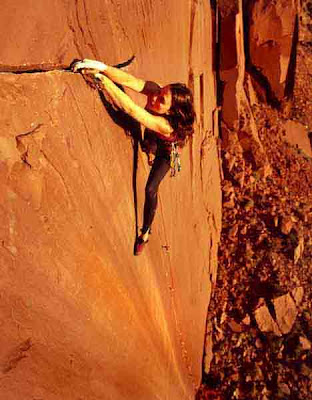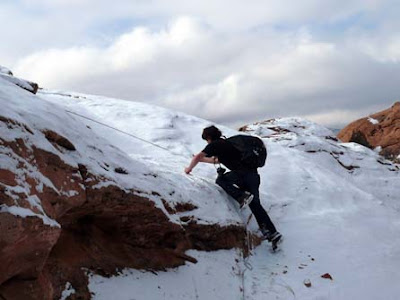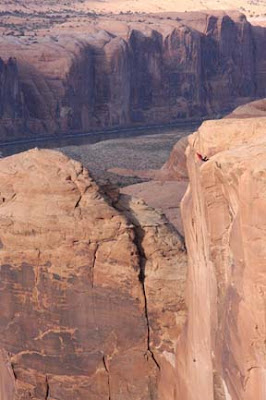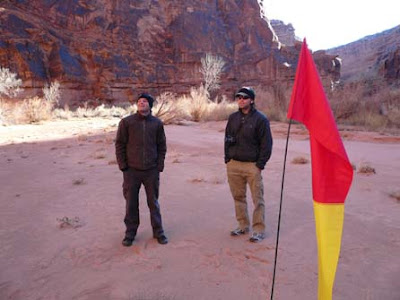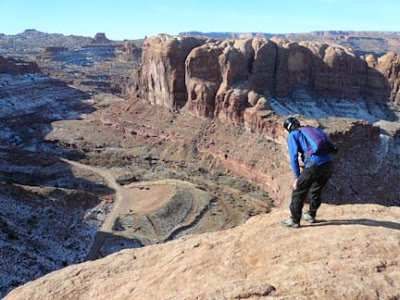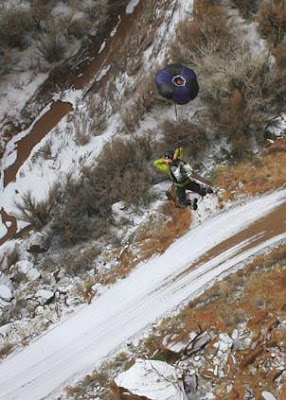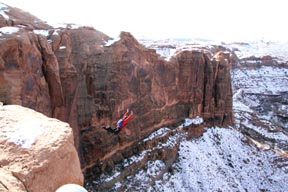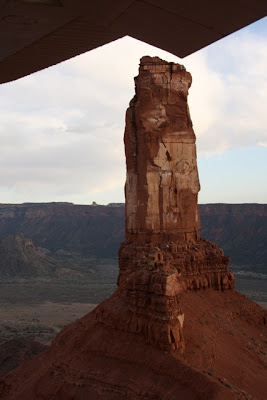
A few weeks ago, I climbed the North Face of Castleton with my friends Mario Richard and Sean Leary, so we could jump it all together. I didn't mention it to them, but I had been holding this idea in my mind for some time....what an amazing experience it would be to free solo that route and BASE jump off the summit! It had been years since I'd done the route, so I was hoping to see how it felt as we climbed together that day, to see if it would be a safe, reasonable free solo for me.
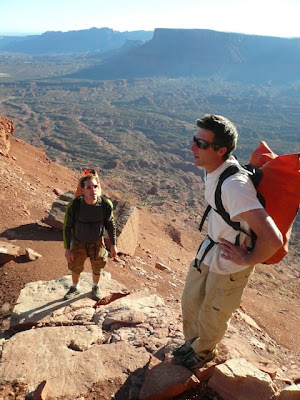
I am so intrigued by the possibilities that are open as a climber and a BASE jumper. If I want to jump Castleton, I just grab my rig and a tag line, and I can be at the base of North Chimney in one hour, and at the summit in another hour, ready to jump. For me, the idea of soloing the striking North Face route seemed like a beautiful thing in itself....and to experience the total freedom of jumping off the top afterward makes it into a unique, aesthetic adventure. I love the concept of combining these wild mountain crafts, with even more creativity.
After our fun day on the North Face, I fessed up to Mario that I was considering the idea of a North Face free solo :) He was immediately intrigued by the idea, and offered to jumar up the route if I wanted to climb it more--then we could jump, so it was definitely a good deal for everyone, as Castleton has to be one of the nicest BASE jumps in the desert, and always a special treat for BASE jumpers, since it requires climbing to get to the summit.
It's great how when someone else is excited about something, it makes it even more fun. I didn't want to make a big project out of the North Face free solo, lassoing partners in to help me. I learned on the Diamond this summer that it's best to find someone who is equally excited to do the climb, and then the preparation part is a lot of fun. It was great that Mario was so enthusiastic about jumping Castleton, and his willingness to climb it any time with me definitely turned my vague ideas into real momentum....
My next trip up the North Face was on a very cold, breezy day, and it felt unreasonably difficult (which wasn't how I wanted it to feel), but at least we got the jump in.
The wind conditions are super important for short, Moab-style BASE jumps. Though Castleton sits way up on the massive talus cone, making for a very fun canopy flight to the road at the bottom, the vertical drop is still less than 400 feet. Since it's so exposed, it's hard to get a true no-wind situation, which is the optimum thing for subterminal jumps. If there is a head wind, you don't want to jump. If there is a cross wind, a decision is required. When your parachute opens, you don't want wind pushing it to open in any other direction than flying straight ahead--since with BASE jumping, the first rule is "don't hit the object!" Castleton's exit point is the southwest arete, between the top of Kor Ingalls and the West Face. This offers a little lee-way for crosswinds, since if your canopy opens a little right or left, the wall is cut away, due to being an arete. Still, every time you go for a BASE jump in Moab, you have to be ready to walk (or in the case of Castleton, rappel) off if the winds aren't right.
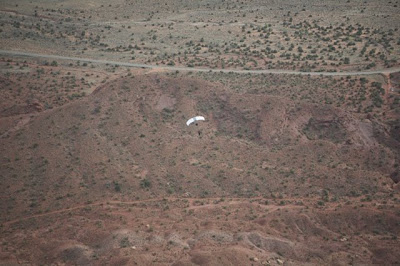
Mario and I climbed the North Face two more times. I felt 90% sure I could be safe on the solo on the third trip.....the fourth made me feel %110 sure, and that's when it was time to make the climb. For me, free soloing is a very different experience than climbing for difficulty. I love the feeling of perfection, of being absolutely certain that I can safely solo the route. Unless I know that is possible, I won't do the solo. Soloing things that are more difficult is a very interesting mental experience. Somehow feelings of fear can take over when the rope is gone, even if you have been climbing in almost equally dangerous, super run-out style. So to me it is really engaging to learn how to prepare my mind to allow me to do things that I know I am physically capable of, but might be too afraid to do. Free soloing at a higher level of difficulty is a place where I can really explore this mental aspect.
I woke up on Sunday feeling less than physically good. I was fighting a little cold, and felt kind of weak and dizzy. But the wind forecast looked the best on that day than for the days to come, and I didn't want to lose my momentum. I also didn't want to solo the route and not get to do the jump. To me, the complete experience of soloing a difficult route and then jumping off was really the cool part! Also, I had a BASE rig stashed on the summit, because Mario and I had tried to get two jumps in one day the week before (running up the North Chimney after we climbed and jumped the North Face), but got stopped by wind conditions for the second jump and had to rappel. So everything seemed in line, except for feeling a little sick. I decided that there were more things in line than out of line, and I should just go slow, and work hard on relaxation and a good mental state. Even feeling a little weak, I thought I should be able to do all the climbing safely, and I decided to go.

When I reached the base, there were clouds and wind. It looked questionable, as to good jumping conditions. But I was there, and things can really change in an hour. The forecast had looked good. I stood at the base, wondering how I would feel. I was trying hard to feel calm and relaxed, and I did have a little bit of doubt about feeling under the weather. I had been listening to my iShuffle on the hike, and suddenly decided I liked the music I was playing, and that I'd just keep wearing it on the route. It seemed to make it easier to relax and clear my mind, so I started up the first crack listening to mellow sounds from Boozoo Bajou.
I got a little excited when I did a step through move onto white calcite at the top of the first pitch, and stepped right on my pant leg, which I had forgotten to roll up. My foot skated off the fabric, but luckily I was in a good hand jam with my right hand buried inside the big undercling flake. Yikes! The unwelcome adrenaline burst was a little draining, and I had to sit on the ledge by the first belay anchor for a long time to rest.
The second pitch felt great, and I sat on the big ledge below the third pitch for a while. This was the part I was really nervous about. If a climb is solid, positive crack climbing, I feel like it's safe for me to solo. Most of the North Face is locker crack climbing. But there is one section on the third pitch where I have to paste my feet up on a bulge, and reach high for a face hold, rather than a jam. Once I have a hold of that, I can wedge my left foot into a horizontal crack, and cross over into a fist jam. Then things are back to crack. But those two moves on the bulge are very intimidating for me without a rope. So I spent some time resting, and thinking about being relaxed and calm, knowing I can climb that crux without struggling. When I felt good, I crossed right over the loose blocks, and started up the wide crack. I hung out in the chimney rest for a while, and then pulled out into the bulge and quickly climbed through the steep moves. I was so happy when I reached the fist jams, and got into the offwidth section above! Now I knew I had nothing to worry about, and would definitely never fall on the end of this pitch. I chimnied up the final corner, and climbed over the top. It had been an intense climb for me, and I felt pretty relieved. The winds had calmed a little, and all I had to look forward now was a great BASE jump!

It was so nice having to put only my rock shoes and chalk bag inside my jacket, and the emergency 5mm rap line down my pant legs--no rack or lead rope to fill my clothing like the michelin man on this jump.
As always this season, there were a few parties of climbers reaching the summit, and they were all so happy to be up there. I love meeting the other climbers on Castleton. Everyone is psyched to be on such a beautiful summit, after a great outing with friends, and it's always so much fun to meet the other parties and swap cameras for summit shots. I went over to the exit point, spat to check the winds, and realized it would be perfect conditions. I looked at my red and yellow flag, so small in the landing area, to decide what would be the best direction for landing (it's always best to try to land into the wind, for a softer landing). Then I set off on a speedy descent--two seconds of freefall, a minute under canopy, and five minutes back to the car......

posted by Steph Davis

